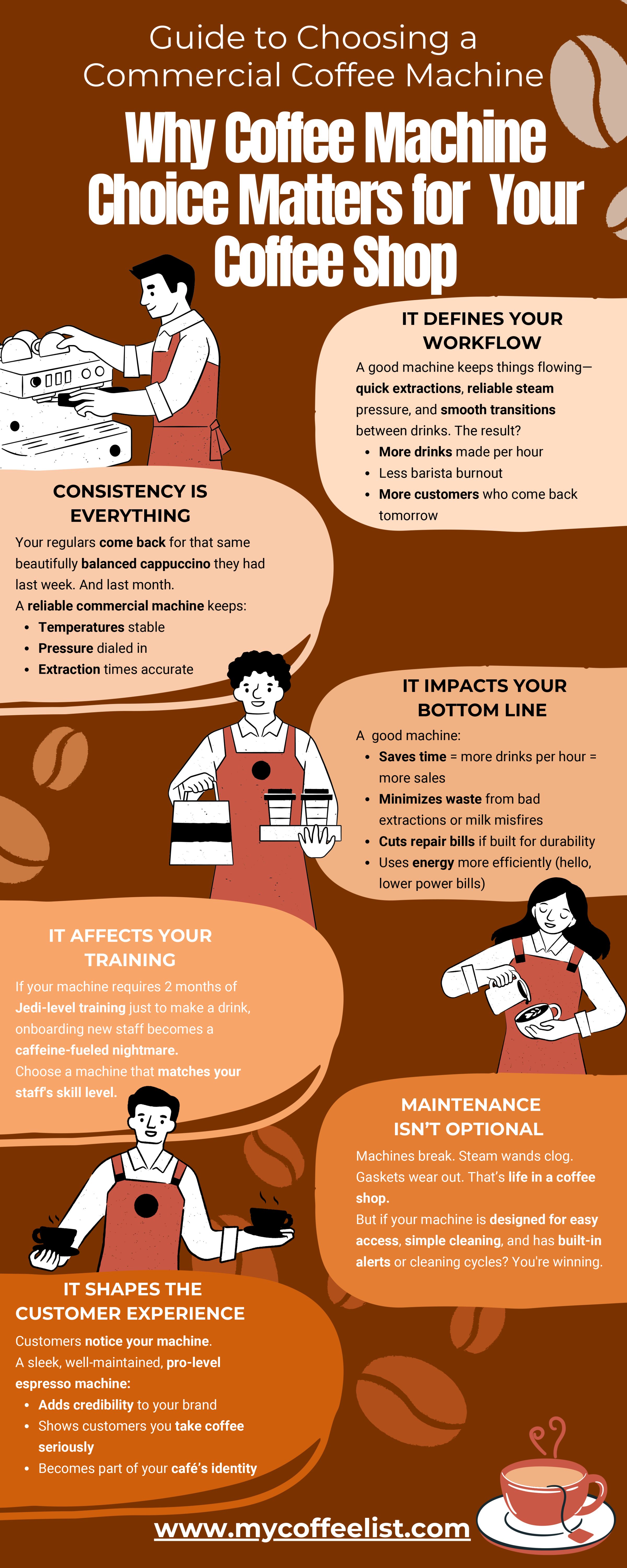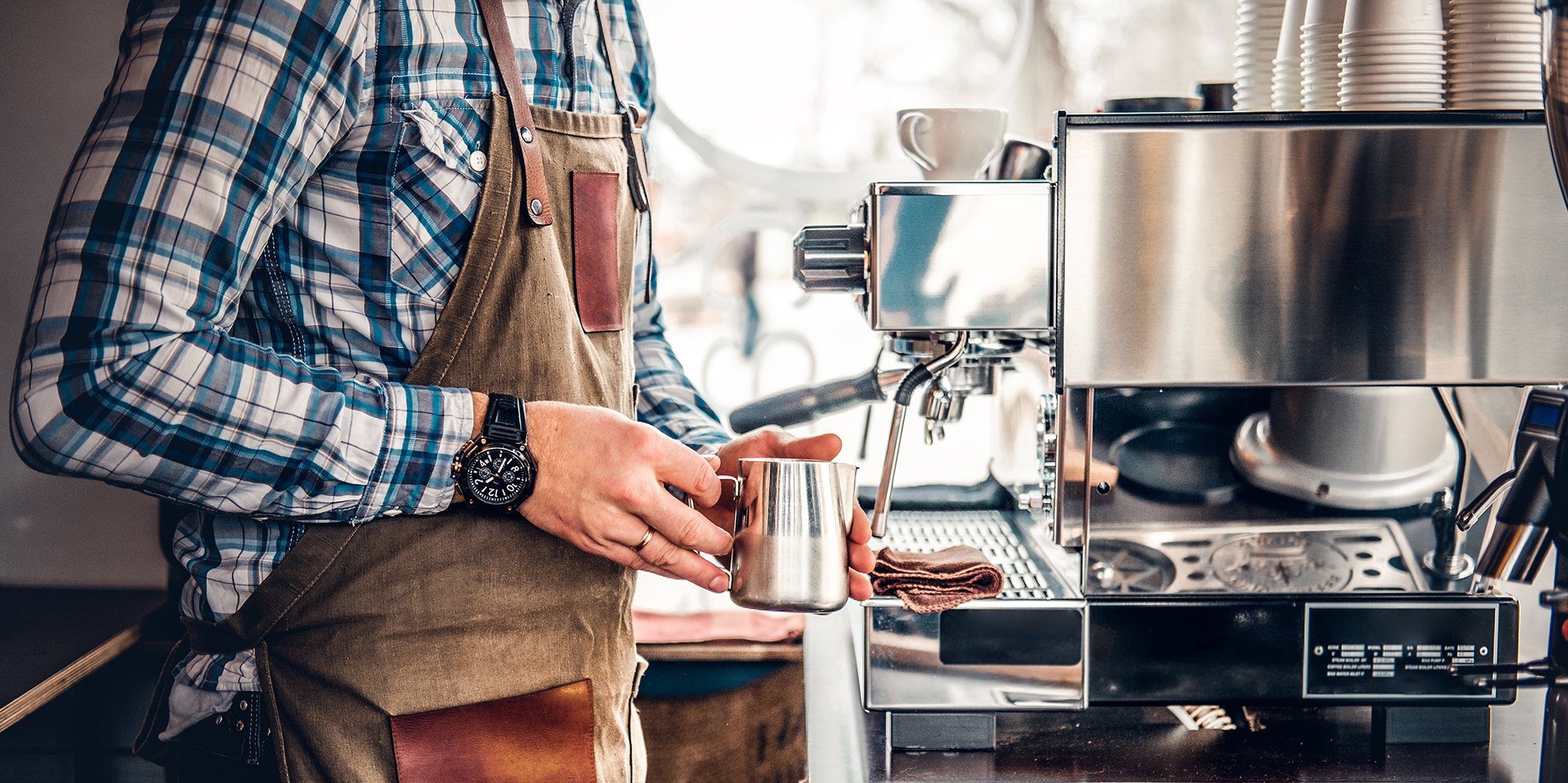The Ultimate Guide to Choosing a Commercial Coffee Machine for Your Coffee Shop
Running a coffee shop isn’t just about latte art and great playlists (though we won’t deny those help). At the heart of your operation—quietly hissing, steaming, and pulling shots all day—is your commercial coffee machine. It’s not just a tool. It’s your partner-in-caffeine, the backstage hero of every flat white and double espresso.
So how do you choose the right one? Let’s talk features, function, and finding the right fit—without the jargon headache.
Why Your Coffee Machine Choice Matters
(Spoiler alert: it’s not just about good espresso.)
Think choosing a coffee machine is just about pressing buttons and watching magic brown liquid flow? Think again. Your espresso machine is the heartbeat of your café—the espresso-slinging, milk-steaming, pressure-powered partner that makes or breaks every flat white, cortado, and caramel oat milk latte.
Here’s why choosing the right one really, really matters:
1. It Defines Your Workflow
Your coffee machine literally sets the rhythm for your baristas. A slow, clunky machine during a morning rush? That’s a recipe for long lines, stressed staff, and frustrated customers checking their watches.
A good machine keeps things flowing—quick extractions, reliable steam pressure, and smooth transitions between drinks. The result?
- More drinks made per hour
- Less barista burnout
- More customers who come back tomorrow
2. Consistency Is Everything
Your regulars didn’t come back for the smile (okay, maybe a little)—they came for that same beautifully balanced cappuccino they had last week. And last month.
A reliable commercial machine keeps:
- Temperatures stable
- Pressure dialed in
- Extraction times accurate
No more "oops, that was a bit sour" or “sorry, this one’s watery.”
In short: happy machine = happy coffee = happy customer.
3. It Affects Your Training (and Turnover)
If your machine requires 2 months of Jedi-level training just to make a drink, onboarding new staff becomes a caffeine-fueled nightmare.
Choose a machine that matches your staff's skill level:
- For high-end specialty cafés: a semi-auto or dual boiler gives skilled baristas full control.
- For high-volume shops: a volumetric or super-automatic helps your team crank out great drinks fast.
Your machine should support your team, not sabotage them.
4. It Impacts Your Bottom Line
That’s right—your espresso machine has a direct line to your profit margins.
A good machine:
- Saves time = more drinks per hour = more sales
- Minimizes waste from bad extractions or milk misfires
- Cuts repair bills if built for durability
- Uses energy more efficiently (hello, lower power bills)
A great machine can actually pay for itself faster than you'd expect.
5. Maintenance Isn’t Optional (So Make It Easy)
Machines break. Steam wands clog. Gaskets wear out. That’s life in a coffee shop.
But if your machine is designed for easy access, simple cleaning, and has built-in alerts or cleaning cycles? You're winning. Because there’s nothing worse than needing a screwdriver and a YouTube tutorial mid-latte rush.
6. It Shapes the Customer Experience
Believe it or not, customers notice your machine. Some will even ask about it by name (looking at you, La Marzocco fans).
A sleek, well-maintained, pro-level espresso machine:
- Adds credibility to your brand
- Shows customers you take coffee seriously
- Becomes part of your café’s identity
(Plus, it's just satisfying to watch a perfectly timed espresso shot pour like liquid gold.)
Choosing your commercial coffee machine isn’t just about specs and stats—it’s about your brand, workflow, team, and bottom line. It’s the difference between a café that’s always in control and one that’s constantly putting out (coffee-scented) fires.
Pick the right machine, and it’ll be more than equipment—it’ll be your MVP.
Types of Commercial Coffee Machines
1. Traditional Espresso Machines (a.k.a. Manual or Semi-Automatic)
These are the beautiful beasts you’ll see in specialty cafés—the ones with gleaming steam wands, portafilters, and enough pressure to launch a rocket.
Pros:
- Full control over shot timing and pressure
- Ideal for skilled baristas
- Great for quality-focused coffee shops
Cons:
- Requires training and consistency
- Slower workflow during rush hours
Best for: Independent shops with trained staff and a strong focus on espresso quality.
Top 3 Traditional (Semi‑Automatic) Espresso Machines for Coffee Shops
1.ECM Synchronika (from $4,495)
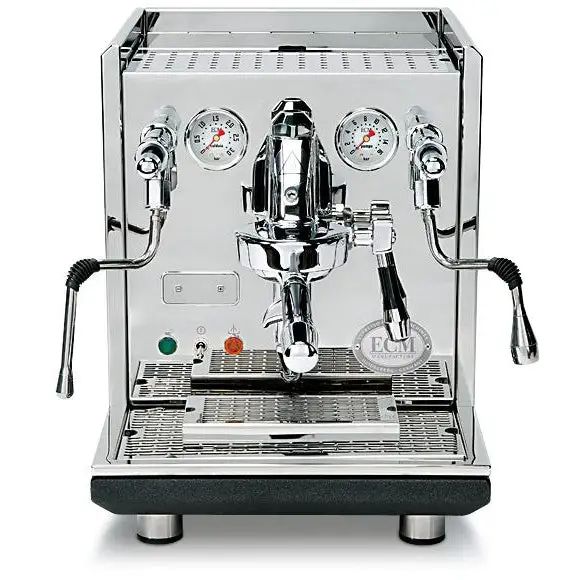
A solid workhorse revered for its durability and precision engineering—this German-made beauty boasts dual boilers, a PID temperature controller, and exceptional steam power, ensuring consistent, high-quality extractions even during busy service hours. It’s reliable, easy to maintain, and built to last.
2. Nuova Simonelli Aurelia Wave (from $9,450)
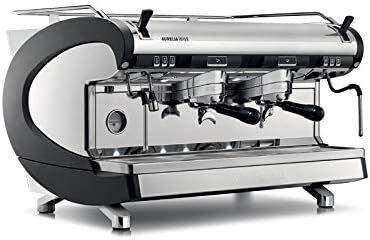
Tailored specifically for coffee shop environments, the Aurelia Wave offers a soft infusion system that delivers rich espresso even if your tamping game isn't flawless. It features an LCD display, automated cleaning cycles, and ergonomic design elements like cool-touch steam wands and lit groupheads. Available in 2- or 3-group units, it's ideal for shops balancing precision, speed, and comfort.
3. La Marzocco Linea Mini (from $6,600)
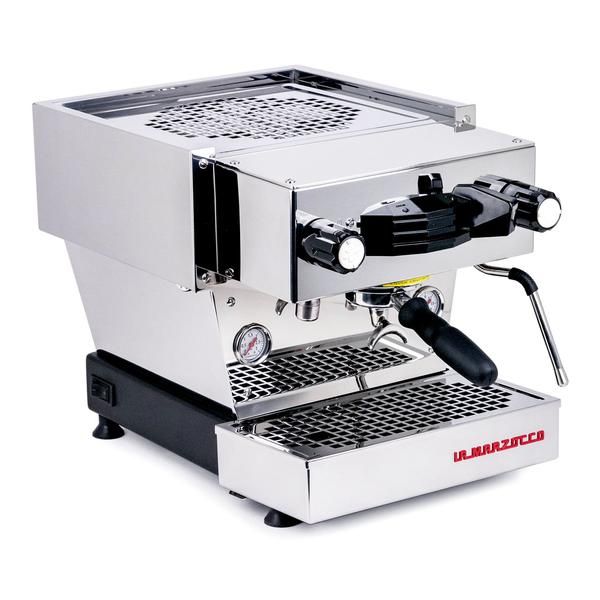
While originally designed for the premium home market, the Linea Mini packs true commercial DNA—with dual boilers, independent PID control, and thermally stable group design. A beloved favorite for its build quality, stunning performance, and café‑level reliability.
Why These Machines Shine in a Coffee Shop
- Consistency & Control: Dual boilers and precise temperature control = better flavor consistency.
- Barista-Friendly: Ergonomic features, reliable builds, and ease of maintenance = smoother operations.
- Scalable for Business: Whether you're brewing for a small specialty café or pushing drinks during the rush, these machines can grow with you.
Quick Comparison Table
| Machine | Standout Feature | Best For |
|---|---|---|
| ECM Synchronika | Precision PID control, robust steam power | Reliable daily use with consistent quality |
| Nuova Simonelli Aurelia Wave | Soft infusion, ergonomic design, automated upkeep | High-traffic cafés needing smooth operations |
| La Marzocco Linea Mini | Cafe-grade dual boiler in compact format | Style-conscious shops valuing precision |
2. Automatic / Volumetric Espresso Machines
These offer pre-programmed shot volumes—press a button, and it does the job with accuracy.
Pros:
- More consistent shots
- Easier for newer staff
- Faster during busy periods
Cons:
- Less flexibility for barista creativity
- May lack the “craft feel” some cafés go for
Best for: High-volume shops where speed and consistency are key (think commuter spots or franchise cafés).
Top 3 Automatic / Volumetric Espresso Machines for Coffee Shops
1.Nuova Simonelli Appia II Volumetric (from $12,399)
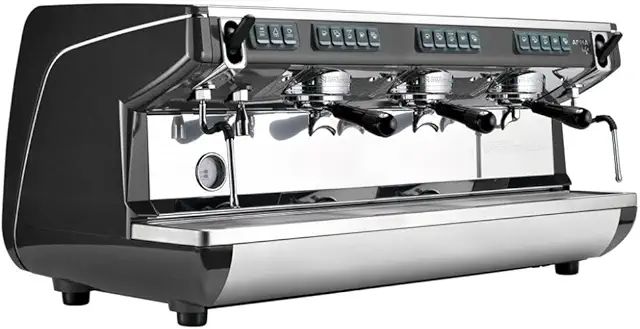
A favorite in busy cafés, the Appia II Volumetric boasts an 11-liter boiler, instant automatic boiler fill, and both volumetric and manual dosing options. Its soft pre-infusion technology nurtures even extraction, while cool-touch steam arms are a barista’s comfort feature. Elegant and robust, it's sleek and stylish—perfect for reliable, high-quality shots during peak hours.
2. La Spaziale S2 EK 2‑Group Volumetric (from $6,750)
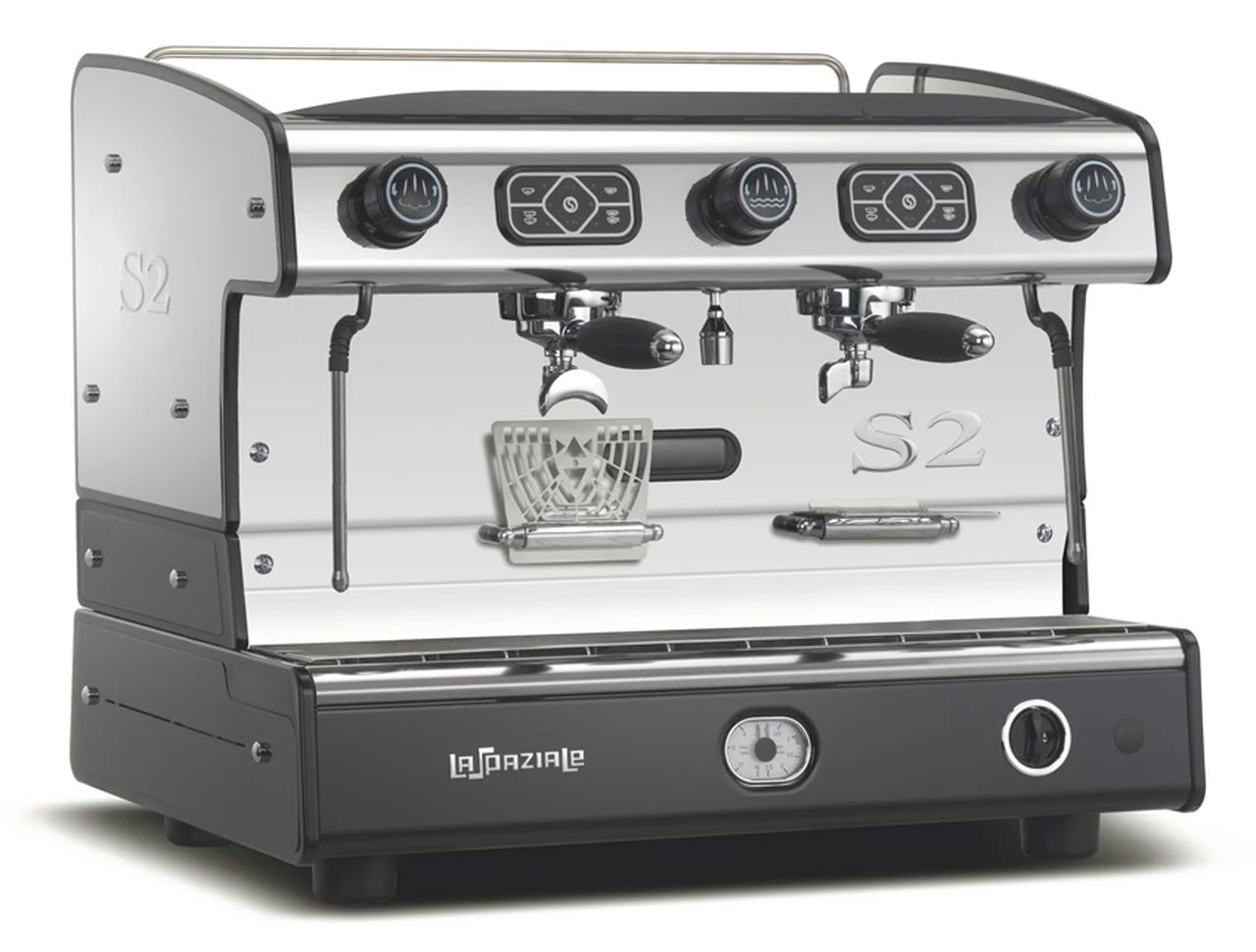
This two‑group workhorse is built for volume and efficiency. It features a generous 10-liter heat exchanger boiler, dual stainless‑steel steam wands, a hot water outlet, and a removable plumbed drain tray. Precision is king here: it delivers consistent espresso through precisely controlled volumetric doses and puts every performance tweak literally at your fingertips.
3. Synesso MVP Hydra (Manual‑or‑Volumetric Programming) (from $13,900)
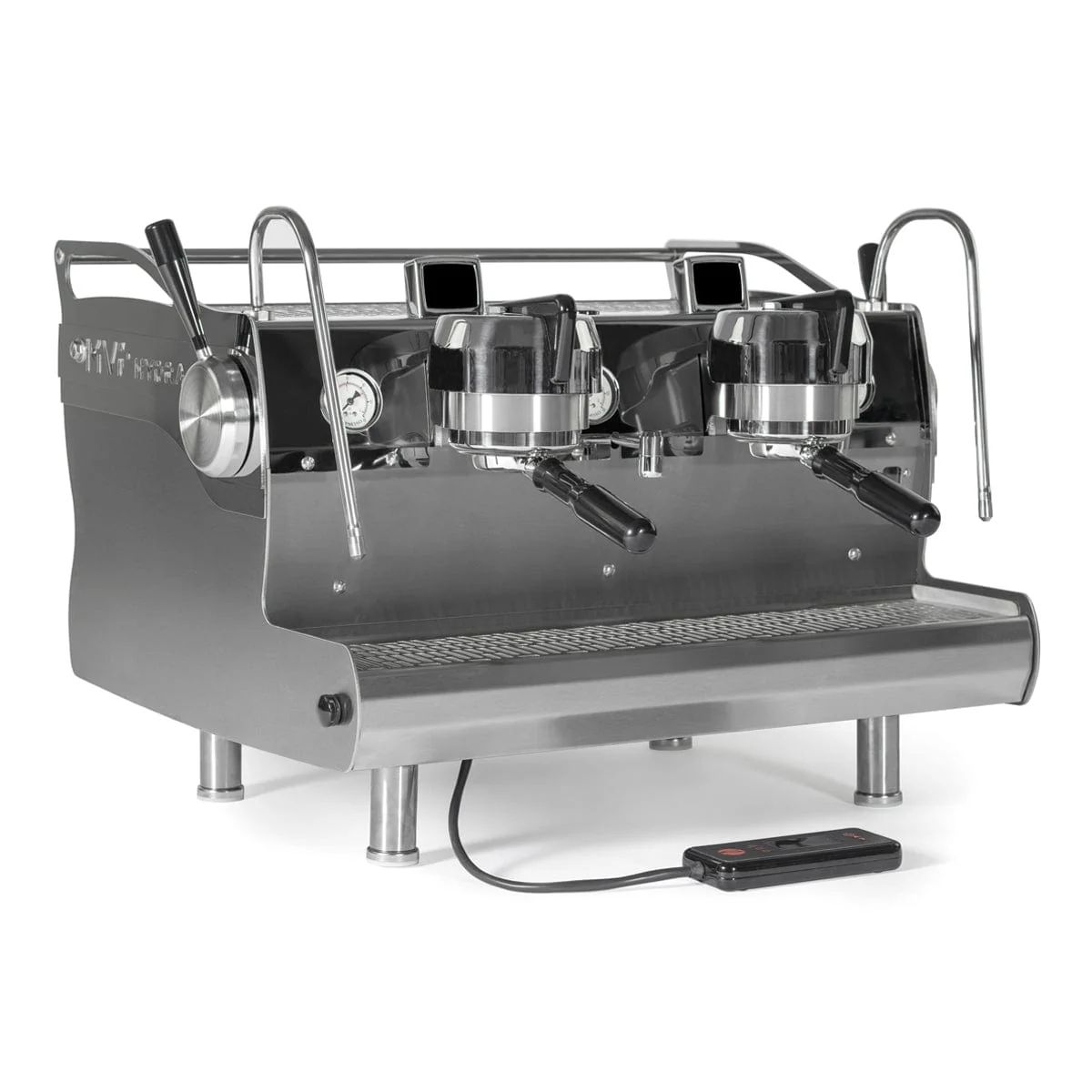
A game-changer for shops that crave barista finesse with volumetric convenience. The MVP Hydra shines with programmable modes for each group, allowing customization of shot parameters like pressure, temperature, and flow—down to near‑scientific precision. Each group has its own pump and motor, maximizing control, workflow, and consistency. Perfect for cafés exploring flavor-first development.
Quick Comparison Table
| Machine | Why It Stands Out | Ideal For |
|---|---|---|
| Nuova Simonelli Appia II | Balanced performance with dosing versatility and reliability | High-traffic cafés needing consistency & speed |
| La Spaziale S2 EK 2‑Group | Robust build, large boiler, volumetric precision | Medium–large shops focused on steady service |
| Synesso MVP Hydra | Ultimate programmability and control | Specialty cafés offering curated flavor profiles |
Choosing a volumetric espresso machine isn’t just about punch cards and drink counts—it’s setting the pace for your entire café experience.
- For consistent, crowd-ready service, the Appia II offers trusted balance.
- Need all-day go-time with reliable flow and precision? The Spaziale S2 EK won’t let you down.
- And if you’re about fine-tuning the perfect shot experience? The Synesso Hydra is finely engineered to bring your flavor dreams to life.
3. Super-Automatic Machines
The push-button wonders. These machines grind, tamp, extract, and even steam milk—no barista required.
Pros:
- Ultra-consistent
- Minimal training needed
- Saves time and reduces staffing pressure
Cons:
- Limited customisation
- Less hands-on feel
- Higher upfront cost (but pays off in labor savings)
Best for: Coffee kiosks, restaurants, or low-labor cafés focused on efficiency over artistry.
Top 3 Super‑Automatic Espresso Machines for Coffee Shops
1.Eversys Cameo (from $21,280)

A premium marvel designed for the pace and precision of real-world coffee operations. This powerhouse can crank out up to 175 drinks per hour, offering both one-step (fully automated milk) and two-step (barista-controlled) milk systems to suit different service styles. It features dual ceramic burr grinders, customizable milk texture settings, a sleek touchscreen, and even remote performance monitoring via telemetry. The Cameo handles dispensing, maintenance, and optimization with near-zero manual intervention.
2. Nuova Simonelli Prontobar Touch (from $14, 699)
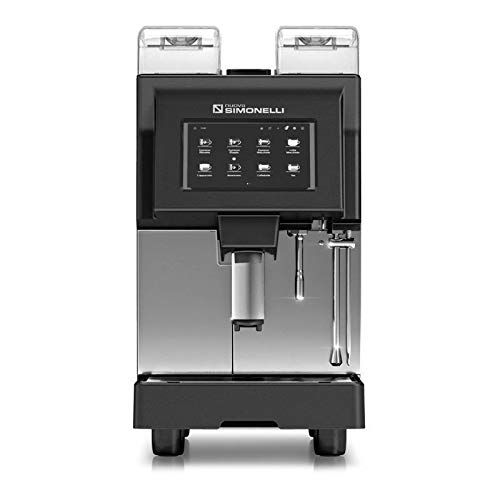
Sleek and smart, this machine gives users the finest touch-based experience. Its vibrant 7-inch touchscreen allows intuitive drink selection, and offers extensive customization—from grind to extraction and milk texture. The integrated EasyCream system crafts professional-quality milk foam, while automatic cleaning cycles simplify upkeep. A solid choice for small to mid‑sized cafés, restaurants, and office environments.
3. Jura GIGA 6 (from $3, 499)
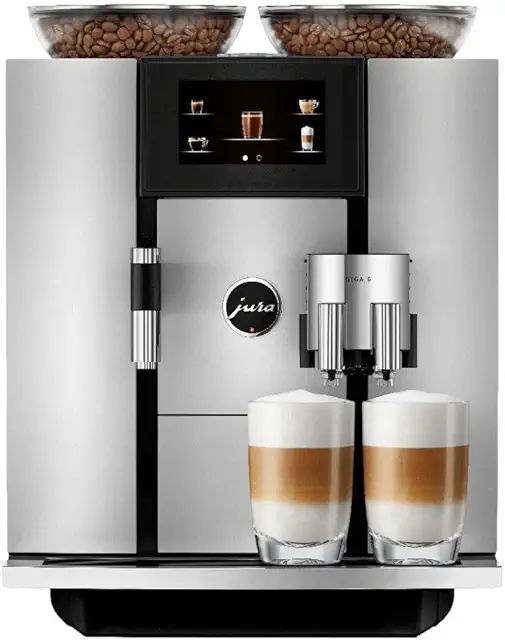
Built for relentless performance, the GIGA 6 is a super‑automatic engineered for high output. With dual grinders and a dual brewing system, it handles up to 200 cups per day while delivering a rich, flavorful espresso. Its touchscreen makes drink programming a breeze, ideal for cafés or busy environments needing efficiency without sacrificing quality.
Quick Comparison Table
| Machine | Strengths | Best Suited For |
|---|---|---|
| Eversys Cameo | Exceptional automation, milk system versatility, remote monitoring | High‑volume shops needing café‑level quality with minimal labor |
| Nuova Prontobar Touch | Full touch control, automated cleaning, customizable beverage settings | Medium‑volume venues seeking sleek automation & control |
| Jura GIGA 6 | High throughput, dual grinders/brewing, intuitive touchscreen interface | Locations pumping hundreds of cups with consistency & speed |
Final Thoughts
- Eversys Cameo is the premium powerhouse—if you need polished, fast, and fuss-free performance all day long, this one's hard to beat.
- Nuova Simonelli Prontobar Touch blends automation with customization in a manageable footprint and price class.
- Jura GIGA 6 delivers industrial-level capacity with user-friendly controls, ideal for bustling cafés or offices.
Key Features Coffee Shop Owners Should Look For
Whether you’re a first-time owner or upgrading your existing setup, here’s what to prioritize:
1. Boiler Type
Your boiler type directly affects your café's speed, consistency, workflow, and espresso quality. Choose wrong, and you could end up with long waits, cranky baristas, and burnt or under-extracted coffee. Choose right, and you’ll glide through peak hours like a pro.
First, What Does the Boiler Actually Do?
The boiler (or boilers) inside your espresso machine heat and maintain water at very specific temperatures for:
- Brewing espresso (around 90–96°C / 195–205°F)
- Steaming milk (much hotter—around 130°C / 265°F)
The challenge? These two functions require different temps, and trying to do both with a single boiler can get... messy.
Common Boiler Types & Why They Matter
1. Single Boiler
One boiler handles both brewing and steaming, but not at the same time.
Pros:
- Affordable
- Simple to use
- Fine for low-volume environments
Cons:
- Slower workflow (you wait to switch between brew & steam temps)
- Inconsistent temp = less predictable espresso quality
Best for: Tiny shops, mobile setups, or home baristas—not ideal for commercial use.
2. Heat Exchange (HX) Boiler
One large boiler stays at steam temperature, and water for brewing passes through a heat exchanger (a metal tube inside the boiler) to reach brew temp.
Pros:
- Brew and steam simultaneously
- Faster service
- Reliable for medium-high volume
- Simpler than dual boiler, but very efficient
Cons:
- Brew temperature can drift slightly if left idle too long
- Requires some flushing and barista experience for consistency
Best for: Most mid- to high-volume cafés that need performance without the cost of dual boilers.
3. Dual Boiler
Two separate boilers—one for brewing, one for steaming—each with its own temperature control.
Pros:
- Maximum consistency and temperature stability
- Brew & steam simultaneously with no compromise
- Ideal for precise espresso work (hello, specialty coffee!)
- Often features PID controllers for fine-tuned settings
Cons:
- Higher cost
- Slightly more maintenance complexity
- Bigger footprint (in some cases)
Best for: Specialty cafés, high-volume operations, and shops where consistency is everything.
So Why Should You Care?
Your Quality Depends on It
Espresso is sensitive to small temperature shifts. The right boiler setup ensures every shot tastes the same, all day long.
Speed & Efficiency Matter
Can your barista pull a shot while steaming milk for three lattes? If not, your line’s about to get long.
Better Workflow = Happier Staff
No more waiting, switching modes, or second-guessing boiler recovery. A consistent machine reduces stress behind the bar.
Fewer Mistakes, Less Waste
Stable temperatures = fewer bad shots = less wasted coffee and milk = better profit margins.
Real-World Example
Let’s say you’re serving 100+ drinks a day, many of them milk-based (flat whites, lattes, cappuccinos). If you’re on a single boiler, your barista has to wait 20–30 seconds to shift between steaming and brewing. Multiply that delay by 100, and you’ve lost over 45 minutes of productivity per day—not to mention the inconsistent drinks.
Prioritize the right boiler system for your volume, menu, and team size, and your espresso machine will serve you beautifully for years.
2. PID Temperature Control
PID stands for Proportional-Integral-Derivative. Sounds like something from a sci-fi film, right?
In simpler terms, it’s a smart thermostat for your espresso machine’s boiler.
Instead of just turning the heater on/off when the water hits a set temperature (like an old-school kettle), a PID system:
- Anticipates temperature changes
- Adjusts gradually
- Keeps the boiler temp within a tight range—often within ±0.1°C (0.2°F)
Why PID Control Matters in a Coffee Shop
Stable Temperature = Consistent Espresso
Espresso is incredibly sensitive to water temperature. Even a swing of 1–2°C can shift your shot from smooth and sweet… to sour or bitter.
Without PID:
- Boiler temps can spike or dip unpredictably
- Your first espresso of the day might taste very different from the 40th
With PID:
- You get repeatable, predictable results
- Every shot tastes like it was pulled by a pro—because it was
It Supports Complex Menus
Do you serve single origins, light roasts, or feature beans with subtle flavor notes?
Those delicate coffees often need different brewing temperatures to shine. A PID controller lets you fine-tune temp to match the bean, and some even let you store different profiles.
It’s like having a barista with a PhD in thermodynamics—without the salary.
Better Recovery Time During Rushes
During a busy morning service, your espresso machine is working overtime:
- Brew a shot → steam milk → brew another shot → repeat
Every action draws energy from your boiler. Machines without PID can struggle to bounce back to temp in time for the next shot.
With PID, recovery is faster and smarter, so your espresso doesn't suffer just because you're busy.
Protects Your Investment
PID doesn’t just help coffee taste better—it helps your machine last longer:
- Prevents overheating
- Reduces wear on heating elements
- Maintains stable operation = fewer emergency repairs
Translation: less downtime, fewer angry Yelp reviews, and more money in your till.
Gives Baristas More Control (or Takes It Off Their Plate)
Depending on the machine, PID can:
- Give expert baristas the ability to dial in their exact temp
- Or, lock down settings so newer staff can’t accidentally wreck your espresso with a wrong button push
It offers flexibility without chaos, and keeps your coffee program running like a well-oiled (and well-caffeinated) machine.
Quick Recap: Why PID Is Worth It
| Without PID | With PID |
|---|---|
| Fluctuating temps = inconsistent shots | Stable temps = consistent flavor |
| Slow recovery during rush hours | Faster bounce-back = smoother workflow |
| More maintenance risk | Less wear and tear, longer machine life |
| Guesswork with delicate roasts | Precision control = better flavor clarity |
If you're serious about espresso quality—and let’s face it, your customers are—you should absolutely prioritize PID control when choosing a commercial espresso machine.
It’s the behind-the-scenes genius that turns a good coffee program into a great one.
3. Plumbed-In vs. Tank-Fed
The choice between plumbed-in and tank-fed espresso machines might not seem like a big deal at first glance, but it has a huge impact on daily workflow, long-term maintenance, and even the quality of your coffee.
Plumbed-In vs. Tank-Fed: Why It Matters (a Lot)
Imagine your espresso machine is a high-performance sports car. Now imagine that every 10 minutes, you have to pull over and refill the gas tank by hand. Annoying, right?
That’s essentially the difference between plumbed-in and tank-fed water supply systems.
- Plumbed-In: Your machine is connected directly to your water line. Water flows in automatically as needed—no intervention required.
- Tank-Fed (a.k.a. Reservoir Machines): Your machine has a built-in water tank that you must manually refill.
Why Coffee Shop Owners Should Prioritize Plumbed-In Machines
Efficiency During Busy Hours
When your café is packed and the drink queue is 12 deep, the last thing you want is:
“Hold on, I need to refill the espresso machine.”
Plumbed-in = no interruptions, ever.
Consistent Water Pressure & Temperature
Tank-fed machines often struggle to maintain stable pressure or heat when the tank runs low.
Plumbed-in machines:
- Provide stable, pressurized water flow
- Help maintain consistent boiler temperature
- Deliver better-tasting espresso shot after shot
Because yes—inconsistent water flow = inconsistent espresso.
Better for High Volume Cafés
If you're pulling more than 30–40 shots per day, you’ll definitely outgrow a tank-fed setup quickly.
Plumbed-in machines are made for:
- Speed
- Scale
- Reliability
They’re the commercial standard for a reason.
Supports Water Filtration = Better Coffee + Fewer Repairs
Plumbed-in machines make it easy to install inline water filtration and softeners. That means:
- Improved water quality = better-tasting coffee
- Reduced limescale buildup = fewer service calls
- Longer lifespan for boilers and group heads
With tank-fed machines, filtration is trickier and less consistent.
Less Hands-On Maintenance
With a tank-fed machine:
- You have to clean the tank regularly (or risk bacteria/mold)
- You constantly monitor the water level
- Baristas may forget to refill, causing overheating or pump damage
With plumbed-in machines:
- The machine handles water levels automatically
- You just brew, steam, and clean as usual—no babysitting required
When Would a Tank-Fed Machine Make Sense?
Tank-fed might be fine if:
- You're a mobile coffee cart without access to plumbing
- You're in a temporary pop-up or event space
- You run a very low-volume café (e.g., <20 drinks/day)
- You're doing training or demos in multiple locations
Even then, you’ll want to factor in refilling logistics and water quality management.
Why Plumbed-In Is Usually the Winner
| Feature | Plumbed-In | Tank-Fed |
|---|---|---|
| Workflow Efficiency | ✅ Seamless | ❌ Manual refilling required |
| Water Pressure/Stability | ✅ Consistent | ❌ Can fluctuate |
| High Volume Readiness | ✅ Built for it | ❌ Not ideal |
| Water Filtration | ✅ Easy to install inline | ❌ More complex or inconsistent |
| Maintenance | ✅ Minimal | ❌ Tank needs frequent cleaning/refilling |
If your coffee shop has access to plumbing, always prioritize a plumbed-in machine. It's one of those behind-the-scenes choices that pays off every single day—in smoother service, better coffee, and fewer headaches.
4. Ease of Maintenance
Can you access the internal parts easily? Does it have self-cleaning cycles? You'll thank yourself at 6 a.m. on a Monday when you need a quick fix.
Why You Should Prioritize Ease of Maintenance in Your Coffee Machine
Save Time = More Coffee, Less Hassle
Coffee shops move fast. When your machine needs cleaning, descaling, or repairs, every minute spent troubleshooting is a minute NOT spent serving customers.
Machines designed with maintenance in mind often have:
- Easy-to-remove parts (like group heads, drip trays, and water filters)
- Clear indicators for cleaning cycles
- Simple access panels for quick fixes
Less fiddling = more flow!
Lower Repair & Service Costs
Complicated machines can be a nightmare for your technician—and your wallet.
If your machine requires specialized tools or long service times, the bill stacks up fast.
Choose models with:
- Common, replaceable parts
- Good manufacturer support
- Self-cleaning cycles or automated maintenance alerts
That means fewer emergency repairs and a longer machine lifespan.
Barista-Friendly = Happier Staff
Your baristas aren’t just coffee pros—they’re machine wranglers too.
If a machine is too complicated to clean or troubleshoot, mistakes pile up, frustration grows, and consistency suffers.
Easy-to-maintain machines let your team focus on what they do best—crafting amazing coffee.
Consistency & Quality Stay Strong
Regular maintenance keeps your espresso machine performing at its best.
Without it, limescale buildup, clogged group heads, or dirty steam wands lead to:
- Off-flavors
- Steam power loss
- Equipment breakdowns
Machines that make maintenance straightforward help keep the coffee quality top-notch—day in, day out.
Faster Training & Onboarding
If your café grows or hires new baristas, a simple maintenance routine means they get up to speed quicker.
Machines with intuitive cleaning and maintenance steps are easier to train on, so your team spends less time figuring out the machine and more time making customers happy.
Quick Maintenance-Friendly Features to Look For
- Removable drip trays and water reservoirs
- Auto-clean and rinse cycles
- Accessible group heads and steam wands
- Clear maintenance alerts or digital reminders
- Easy-to-change water filters and grinders
When choosing your commercial espresso machine, don’t just focus on bells and whistles—think about the daily grind behind the grind. A machine that’s easy to maintain is like having a reliable teammate who never calls in sick.
5. Group Heads
Prioritizing group heads when choosing a commercial espresso machine is like choosing the engine in a race car — it’s absolutely central to how your espresso flows, tastes, and performs under pressure.
Why You Should Prioritize Group Heads in Your Espresso Machine
The Heart of Your Espresso Extraction
The group head is where the magic happens: it’s the part of the machine that delivers hot water evenly through the coffee puck.
A well-designed group head ensures:
- Consistent water distribution
- Stable temperature right at the coffee grounds
- Proper pressure for ideal extraction
A bad or cheap group head? Expect uneven shots, channeling, and disappointing flavor.
Temperature Stability & Thermal Mass
Quality group heads often feature materials like brass or chrome-plated brass, which retain heat well—this is called thermal mass.
Why does that matter?
- It keeps the brewing temperature steady throughout the day
- Prevents temperature drops between shots (no more cold slugs ruining your espresso)
- Contributes to consistent, repeatable flavor profiles
Speed & Efficiency During Busy Service
Good group heads help baristas pull shots faster with less fuss. Some advanced machines offer:
- Saturated group heads (water surrounds the entire brewing chamber) for more even heating
- Pre-infusion technology integrated at the group head, gently wetting the grounds before full pressure hits to reduce channeling
These features mean better extraction and faster shot times — a win-win during rush hours.
Ease of Cleaning & Maintenance
Group heads get coffee oils, grounds, and residue trapped daily. Machines with group heads designed for:
- Easy disassembly
- Accessible gaskets and screens
- Smooth surfaces to prevent buildup
Make your baristas’ cleaning routine faster and more effective — keeping espresso tasting fresh and avoiding costly repairs.
Compatibility & Upgradability
Some commercial machines let you swap or upgrade group heads—great if you want to experiment or future-proof your setup.
Plus, well-known brands often have widely available replacement parts, saving you downtime if something goes wrong.
Choose a machine with high-quality, thermally stable, easy-to-maintain group heads, and you’re giving your coffee program a rock-solid foundation for success.
Top Commercial Machine Brands Worth Knowing
| Brand | Known For | Good For |
|---|---|---|
| La Marzocco | Italian heritage, premium build, dual boiler | Specialty cafés, artisan shops |
| Nuova Simonelli | Durability, ease of use, affordability | High-volume shops, training cafes |
| Sanremo | Tech-forward, visually striking machines | Design-conscious, modern cafés |
| Victoria Arduino | Advanced tech + sleek design | Specialty and high-end cafés |
| Franke | Super-automatic precision | Offices, self-serve cafés |
| Jura | Swiss-made super-autos | Hotels, restaurants, bakeries |
What About Cost?
- Entry-level (semi-auto): $3,000 – $7,000
- Mid-range (2-group machines): $8,000 – $12,000
- High-end / Super-automatic: $12,000 – $25,000+
Remember, you’re not just buying a machine—you’re investing in workflow, quality, and customer experience.
Pro Tips for Choosing the Right Machine
- Think 12 months ahead: Don’t buy just for today’s volume—anticipate growth.
- Factor in water quality: Poor water = damage + bad taste. Always filter.
- Test before you invest: Many suppliers offer demos—take advantage.
- Support matters: Choose brands with reliable local servicing and support.
- Train your team: Even the best machine won’t fix poor technique.
Choose Your Coffee Machine Like You’d Choose a Business Partner
When your espresso machine runs smoothly, your café runs smoothly. It’s the heartbeat of your bar, the mood-setter for your staff, and the first thing customers hear in the morning. So pick wisely, love it well, and keep it clean (seriously, daily backflushing isn’t optional!).
Think of it less like a gadget and more like a dependable partner who shows up every day ready to perform.
Here’s why that mindset matters:
It Has Your Back (and Your Baristas’ Too)
Just like a great business partner, your espresso machine should support your team—not slow them down or cause headaches. It needs to be reliable, efficient, and easy to work with, especially when the pressure’s on during the morning rush or weekend brunch.
Consistency Is Non-Negotiable
In business and coffee alike, consistency breeds trust. Customers expect their favorite latte or espresso to taste just right every single time. Your machine’s temperature stability, pressure control, and smart features ensure that you deliver the same quality cup from the first shot to the last.
Growth-Friendly
A true partner grows with you. Your coffee machine should be scalable, adaptable, and built to handle increasing demand without missing a beat. Whether you’re expanding your menu, hiring new baristas, or increasing your foot traffic, your machine should keep pace seamlessly.
Saves You Money and Time
The right machine isn’t the cheapest upfront—it’s the one that helps you save on waste, repairs, and downtime. It’s the one that lets your baristas focus on crafting coffee rather than troubleshooting gear. Ultimately, it’s a smart investment that pays dividends daily.
Fits Your Unique Flavor & Vision
Every café has its own vibe, goals, and clientele. Your coffee machine should reflect that—offering the right balance of automation and control so you can showcase your signature style, whether that’s perfect espresso shots or creative milk drinks.
So, before you decide…
Pause, reflect, and ask yourself:
- Does this machine help me serve my customers better?
- Will it empower my team rather than frustrate them?
- Can it grow with my business?
- Is it a partner I can trust every busy morning?
If the answer’s “yes,” congratulations—you’ve found more than a machine. You’ve found a partner in success.
